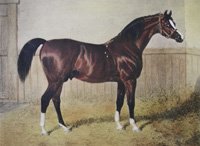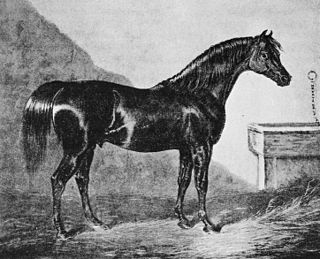Related Research Articles

The American Saddlebred is a horse breed from the United States. This breed is referred to as the "Horse America Made". Descended from riding-type horses bred at the time of the American Revolution, the American Saddlebred includes the Narragansett Pacer, Canadian Pacer, Morgan and Thoroughbred among its ancestors. Developed into its modern type in Kentucky, it was once known as the "Kentucky Saddler" and used extensively as an officer's mount in the American Civil War. In 1891, a breed registry was formed in the United States. Throughout the 20th century, the breed's popularity continued to grow in the United States, and exports began to South Africa and Great Britain. Since the formation of the US registry, almost 250,000 American Saddlebreds have been registered and can now be found around the world, with separate breed registries established in Great Britain, Australia, continental Europe, and southern Africa.

Messenger was an English Thoroughbred stallion imported into the newly-formed United States of America just after the American Revolution. He is most famous for being the great-grandsire of Hambletonian 10, the father of all American Standardbred horses. Though he did not have a long racing career himself, he was a common ancestor in many successful racing horses into the 20th century.

Sultan (1816-) was a British-bred Thoroughbred racehorse and a leading sire in Great Britain and Ireland for six successive seasons.

Diomed, foaled in 1777, was an English Thoroughbred race horse who won the inaugural running of the Derby in 1780. He was subsequently a successful sire in the United States.

Middleton, also known as Chestnut Middleton, was a British Thoroughbred racehorse and sire. His racing career consisted of a single race: a win in the 1825 Epsom Derby. Training problems prevented him from racing again, and he was retired undefeated to stud. He was exported to Russia in 1833.
Paris was a British Thoroughbred racehorse. In a career that lasted from April 1806 to April 1808, he ran fourteen times and won seven races. In 1806 he won the Derby on his third racecourse appearance shortly after being sold by his breeder. Paris stayed in training for two more years and had some success in match races. His racing career was ended by an injury at Newmarket Racecourse in 1808, after which he was retired to stud where he proved a to be a complete failure.
Ditto (1800–1821) was a British Thoroughbred racehorse and sire. During a racing career that lasted from May 1803 to April 1807 he was lightly campaigned, running six times in five seasons and winning four races. In the summer of 1803 he proved himself one of the best British colts of his generation, by winning Derby on his only appearance on the season. He went on to win two important races at Newmarket and a King's Plate at Guildford. Ditto was retired to stud in 1808 and had some success as a sire of winners.

Skyscraper (1786–1807) was a British Thoroughbred racehorse. One of many notable offspring of the great Highflyer, Skyscraper is best known for winning The Derby of 1789. He competed until he was seven, when after losing two races he was retired to stud.
Archduke was a British Thoroughbred racehorse and sire. In a career that lasted from April to October 1799 he ran four times and won two races. On his second racecourse appearance he won The Derby defeating his more fancied stable companion, Eagle. Archduke was beaten in two races at Newmarket later that year and did not race again. He was later exported to stand at stud in the United States.
Noble was a British Thoroughbred racehorse and sire. In a career that lasted from May 1786 to May 1788 he ran at least three times and won two races. He won the seventh running of The Derby as a 30/1 outsider in what was probably his first race. His only other success came at Newmarket later that year. He was retired to stud where he stood as a stallion for several years but made little impact as a sire of winners.

Bay Bolton or Brown Lusty (1705–1736) was a British Thoroughbred racehorse who won Queen Anne's Gold Cup as a five-year-old in 1710. After retiring from racing he became a successful sire for the Charles Paulet, 2nd Duke of Bolton, and his son Charles Powlett, 3rd Duke of Bolton, was Champion sire seven times.
Snip was a British Thoroughbred racehorse. He only won one race, but later became a successful sire. His son Snap was undefeated in his four races and became a multiple-time Champion sire. Snip was bred and owned by William Cavendish, 3rd Duke of Devonshire.

Filho da Puta was a British Thoroughbred racehorse. He won nine of his 12 races including the St. Leger Stakes and Doncaster Gold Cup. He also sired St. Leger winner Birmingham and was the leading sire in Great Britain and Ireland in 1828. He was owned by Sir William Maxwell and later T. Houldsworth. His name means "son of a bitch" in Portuguese.

Walton was a British Thoroughbred racehorse. He raced until he was eight years old, winning sixteen of his twenty five races. His first race was in 1802, with his first big win, the Third Class of the Oatlands Stakes, coming in 1803. He went on to win eight King's Plates and recorded wins over several leading racehorses of the time. He was owned by Sir Hedworth Williamson throughout his racing career. Walton later became a successful stallion and was champion sire of Great Britain twice. He sired the Derby winner Phantom, 2000 Guineas winner Nectar and St. Leger winner St Patrick.

Black Allan or Allan F-1 was the foundation sire of the Tennessee Walking Horse. He was out of a Morgan and Thoroughbred cross mare named Maggie Marshall, a descendant of Figure and the Thoroughbred racing stallion Messenger; and sired by Allandorf, a Standardbred stallion descended from Hambletonian 10, also of the Messenger line.

Ethan Allen was an influential Morgan horse sire and trotting racehorse.
Black Hawk (1833–1856) was an influential Morgan horse sire. All Morgan horses alive today have multiple pedigree crosses to this stallion. He has more influence on the Morgan breed than any other horse other than the foundation sire of the breed, Justin Morgan.
Gaines' Denmark was one of the most influential stallions in the development of the American Saddlebred.
Harrison Chief was an American Saddlebred stallion, who was chosen as the second foundation sire of his breed.
Australian was a British-bred Thoroughbred racehorse and sire. He was exported to the United States where he had modest success as a racehorse but became a very successful and influential breeding stallion.
References
- 1 2 Rachel Grack (1 August 2008). American Saddlebred Horse, The. Bellwether Media. pp. 19–. ISBN 978-1-61211-544-3.
- ↑ "Spokane Daily Chronicle - Google News Archive Search". news.google.com.
- ↑ American Saddlebred Association: About us
- ↑ Lynghaug, Fran (2009-10-15). The Official Horse Breeds Standards Guide: The Complete Guide to the Standards of All North American Equine Breed Associations. MBI Publishing Company. ISBN 9781616731717.
- ↑ Coleman, Lori (2006). The American Saddlebred Horse (Print book) (Juvenile audience). Edge Books Series. Mankato, Minn.: Capstone Press. ISBN 978-0-7368-5458-0.
- 1 2 "Bureau of Animal Industry". 20 May 1903 – via Google Books.
- ↑ Just the right horse: about
- ↑ American Saddlebred
- 1 2 Gaines' Denmark sons and grandsons #1
- ↑ Washington Denmark Offspring
- ↑ WORLD’S GRAND CHAMPIONSHIP FIVE-GAITED STAKE
- 1 2 Gaines' Denmark sons and grandsons #2
- ↑ Montrose: Saddlebred Beauty and Style
